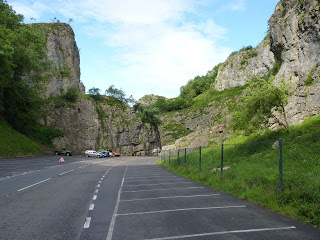Our students have gone and things are quiet as we prepare to wrap up the year. Some have been curious about what we did here to stay occupied. The question most often seems to come from colleagues who can't believe this program, with only a dozen students and three courses to teach in the year, could possibly be a full-time job. While there's no easy answer for precisely what it is we did, let me assure you that we had plenty to keep us busy.
In the 1993 motion picture Groundhog Day, Bill Murray's character is condemned, by unnamed metaphysical forces, to live the same day (2 February) over and over again until he gets it right. I don't feel as though I've been condemned to anything, but my days here in England took on a certain Groundhog Day-like routine -- at least the first part of the day.
 |
| We were awakened by the boiler, even in June |
In the mornings we were been awakened by the timer on our heating system (yes, even in June!). When the boiler kicked in, around 6:45 a.m., we'd hear a bit of clanking in the radiators which stirred us out of bed. I generally made coffee while Mary hit the shower, then took my turn getting clean. After dressing, I checked my email -- because of the time difference, anything sent late afternoon or evening in the U.S. arrives over night here.
 |
| Nuthall Road was usually busy with traffic |
Breakfast was followed by a check of U.S. newspaper websites to see what's happening at home. By 8 I was off to the news shop to get a newspaper. I invariably met the same kids going to school, the same workers awaiting their ride at the bus stop.
 |
| An unusually calm view of Nuthall Road bus stops on a bank holiday morning |
Jack, the proprietor at J & S News, was always good for a morning chat, and we solved the world's problems for a few minutes. On the way home I would see the guys at the used car dealership opening up, even see some of the same delivery "lorries" (trucks) in the neighborhood.
 |
| Jack at J&S news always had a smile and a laugh |
After we read the paper I would take it over to the flat so that the students could read it also (reading daily papers was part of their assigned course work). When I get there around 9 a.m. few are up and around. One or two may have gone to class already, and a couple more may have been eating breakfast. The rest were still in bed. These are college students, after all, and they were probably up well past midnight "studying," or something.
 |
| Unfortunately I didn't get a shot of J & S when it was open, 6 to 6 daily. |
I made my rounds of the building, checking doors, thermostats, lights, etc., and generally making sure nothing bad is happening, then head home once again. From here on, there is no routine. Groundhog Day is over and every day is different.
Monday was class day. We met in the evening, but my preps often went most of the day.
Tuesdays and Fridays were shopping days. It usually took an hour and a half or more for both of us, along with one student, to fill two "trolleys" (shopping carts) and get all those groceries back to the pantry in the flat. Mary spent many more hours organizing cooks, menus, and shopping lists.
Other mornings were often reading or writing time. Luther insists I keep a detailed spreadsheet of all our bills and expenses, and this usually requires a daily update. There may have been assignments to grade, trip itineraries to lay out, reservations to make, lessons to plan. Keep in mind that in this gig, I was not only the professor, but the dean of students, head resident, financial services director, buildings & grounds supervisor, cafeteria manager, counseling center staff, chaplain, housekeeping supervisor, etc., etc.
 |
| Bringing over the newspaper gave me an excuse to make my rounds at the student flat |
After lunch Mary and I almost always took a walk of at least a couple miles. Often we would use this to go on a mission for some program-related errand. Perhaps it was be to the grocery store for some forgotten or last minute item, to the post office, or to the bank, or a hardware store.
The rest of the afternoon were more desk work, or maintenance duty. One recent day I spent much of the afternoon fixing bicycles (for this I got a Ph.D.?). Another day I was on a ladder, scrubbing mold off the ceiling in one of the flat bedrooms (this is England and it's damp).
 |
Buses -- I was planning a full blog post on Nottingham mass transit,
but I didn't get to it. |
The early morning may be a Groundhog Day routine, but from there it's anything but routine. Yet the to-do list never grows short. I was the teacher, but also the dean of students, counselor, chief of buildings and grounds, comptroller, and CEO. And much of what we did took three times as long because we had to figure out how to do it the English way, which we weren't used to. But in less that three weeks, we'll be getting reacquainted with America once again.


















































